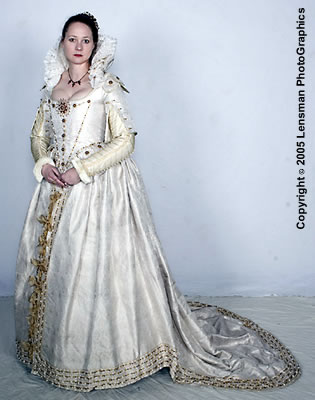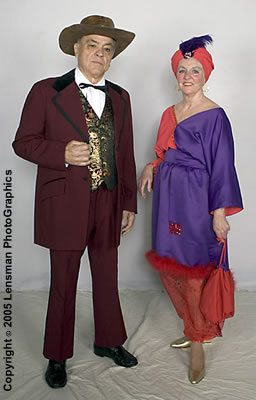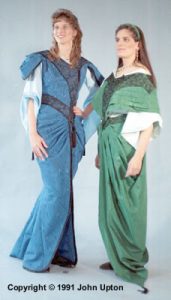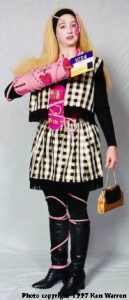CC23-H-15: Paul Poiret Designs for the Red Hat Society
Competition Staff & Rules
Staff:
- Director: Darla Kruger
- Master of Ceremonies: Elaine Mami
- Presentation Judges: Elizabeth Gerds, Pierre E. Pettinger, Jr. and Kendra Van Cleve
Rules:
HISTORICAL MASQUERADE RULES and CONTESTANT INFORMATION
I. INTRODUCTION
A. CC23 HISTORICAL MASQUERADE STATEMENT
The Costume-Con 23 Historical masquerade will take place on Sunday, May 1, 2005. The costumes entered in the Historical Masquerade shall be any costume of history up until 1975.[1] This will include any historic time period, ethnic group, country, and/or culture from the past.
The deadline for mailing your entry form and release is April 9, 2005. If you are entering masquerade upon arrival at Costume-Con 23, your completed entry form and release must be submitted no later than 12:00 p.m., Saturday, April 30, 2005, location to be announced.
[1] See section on Ethnic entries for exception to 1975 time limit rule.
B. CC23 HISTORICAL MASQUERADE DIRECTOR’S STATEMENT
While the rules and contestant information below may seem overwhelming, it wasn’t my intent to make them so. I wanted to create a set of rules and guidelines to actually make the process easier to deal with and clearer to understand from the very beginning. I have tried to communicate exactly what it is that I believe is needed to make our show and competition run smoothly, efficiently, and with the maximum amount of fun for all.
Costuming is always an art form, whether it’s Science Fiction, Fantasy, or Historical. In order to avoid controversies, misinterpretations, and misunderstandings by contestants and judges caused by ambiguities in the rules and instructions, I have tried to be very understandable and complete in writing these instructions, yet still allow for individual creativity. It was NOT my intent in writing these rules and instructions to create a repressive or dictatorial atmosphere.
If we have an event where people can worry more about what their costume looks like and producing that costume, than what is meant by something contained in these rules and instructions, everyone will have a much better time. After all, it should be all about having fun and designing and creating fantastic costumes!
My special thanks to Byron Connell, Henry Osier, Nancy Mildebrandt, and Pierre E. Pettinger, Jr. and Sandy Pettinger for helping me construct these masquerade rules and instructions. But remember, if you hate them, it’s my fault.
II. COSTUME ENTRY CATEGORIES
While we have attempted to cover all the bases and come up with every type of category and sub-category that might be imagined during a historical masquerade, we may not have gotten them all (and probably didn’t). Please do not think the below-listed categories are the only ones allowed in the Historical Masquerade. If you come up with something imaginative and aren’t sure whether to enter the Historical Masquerade, or in which category to enter your costume, contact the Masquerade Director for guidance.
A. HISTORICAL REPRODUCTION
Reproduce: To produce a counterpart, image, or copy of; to produce again or anew; to undergo copying.[2]
[2] A paraphrased definition from The American Heritage Dictionary.
1. What Constitutes “Historical Reproduction”
Costumes in this category are designed to be reproductions or as close as possible with modern equivalents to an original garment from a past period of time. Documentation requirements for this category are more stringent and detailed because the standards for reproduction garments are different. The cut-off date for Historical Reproduction entries is 1975.
The following is what should be a fairly comprehensive list of the types of costumes that will fall into the “Historical Reproduction” category. If you are unsure whether your costume meets one of these definitions, contact the Masquerade Director for guidance.
Frankensteining:
This is a costume created from a conglomerate of design elements from a specific era or period during which those design elements would have been used. Example: a costume created using an 1890 style sleeve with an 1890 style skirt with an 1890 style bodice. In other words, you are acting the part of the period “designer” by using period-correct fashion elements.
Extant Garment:
This is a costume reproduced using an extant garment as your source. An extant garment is one that actually still exists. Your original source can be either from a museum collection, your personal vintage collection, or some other source where you have hands on access to vintage or antique clothing. This is the best type of “primary source” for a costume. Example: you have your grandmother’s actual 1922 wedding dress and reproduce the dress as closely as possible to the original. The reproduction does not need to include the original size of the extant garment.
Fashion Plate:
This is a costume reproduced from a fashion plate or a fashion photo from a magazine/book of any period up to 1975. Example: you have a fashion plate from a 1905 “Delineator.” In this particular magazine you have found a design for a beautiful yellow dinner dress. You reproduce this dress extrapolating what the back of the gown looks like since there is no drawing of the back.
Original Photograph:
This is a costume reproduced from an original photograph taken during the actual era. This type of reproduction, of course, doesn’t apply to pre-photography periods. Example: you have a photograph of an 1845 middleclass gentleman playing cards and you reproduce the suit he’s wearing.
Artwork:
This is a garment reproduced from a historical painting or portrait. While many garments depicted in artwork would not have actually existed or have been worn, if the costume is a reproduction of a garment from a painting and uses historically accurate construction techniques for the period in which the painting was made, it will fall in the Historical Reproduction category. Example: You reproduce Mrs. Siddons’ portrait by Raleigh. Even though this is a gown probably only used in the artist’s studio and would not have been worn in real life, the reproduction of the gown from this historical painting would be considered historical reproduction.
Theatrical Source:
This is a reproduction of a historical costume from a historic theatrical source. The sewing techniques should be those of the period in which the film or theatrical source was produced. Example: you reproduce the Mary Poppins’ red and white carousel dress from the 1964 Walt Disney film. This will be considered a Historical Reproduction even though the dress may not be “period correct” for the historical era in which the film was set; it is a reproduction of a historical film. In this case, the sewing techniques used for this entry should be those of 1964 when the film was made, not 1911 when the story took place. You are reproducing a film costume, not a purely historic garment.
2. Historical Reproduction Costume Requirements
The following is a list of requirements for each individual costume entered into the Historical Reproduction category.
Components:
All entries for this category must include period-correct underwear or underpinnings where applicable or appropriate, as well as accessories. In other words, the requirement for these entries is “from the skin out.” Even the underpinnings must be made using historically accurate methods, techniques, and materials whenever possible. Some parts of the historical reproduction costume may be purchased items: i.e. stockings, shoes, hats, leather goods (belts, purses, etc.) and certain other accessories. The main body of the garment, however, MUST be custom made. Of course, every additional part of the costume that is custom made will allow the judges to add “brownie points” in your favor.
Fabrics/Construction Materials:
Fabrics must be historically accurate as best as possible with modern available textiles and materials. We realize not all period fabrics and materials are available or affordable. While judges will not be doing a fiber test, if a fabric looks incorrect for the period (i.e. petroleum based fabrics for an 1865 gown), it will count against the costume unless that fabric would have been used for that garment (example: a 1975 leisure suit made out of double-knit stretch polyester would be an appropriate and accurate — albeit gross — fabric choice). The use of such components as Rigilene and other modern materials will count against a Historical Reproduction garment unless the garment is from a period these materials were available and used for this purpose.
Construction Techniques:
Visible (both inside and outside) sewing and finishing techniques must be historically accurate or at least appear so. However, hand-sewing the complete garment is NOT required. Machine sewn buttonholes are acceptable in all circumstances (but remember, hand embroidered ones will get you brownie points). Visible use inside or out of serging, zig-zag stitching, and other obviously modern finishing techniques will count against your entry for periods these techniques did not exist.
B. HISTORICAL INTERPRETATION
Interpretation: A representation of the meaning of a work of art as expressed especially in representation or performance.[3]
[3] A paraphrased definition from The American Heritage Dictionary.
1. What Constitutes “Historical Interpretation”
The idea of the Historical Interpretation category is that the fabrics and sewing techniques are not historically accurate but interpretive. The goal of the costumer is to create the “effect” of the historical period or “interpret” it, rather than reproduce an original garment. This category also allows for a different type of artistic and imaginative creativity. This is not a “skin out” category, historically accurate underpinnings and underwear are not required. However, all costumes in this category must be based on a “historical” source. The cut-off date for Historical Reproduction entries is 1975.
The following is what should be a fairly comprehensive list of the types of costumes that will fall into the “Historical Interpretation” category. If you are unsure whether your costume meets one of these definitions, contact the Masquerade Director for guidance.
Twisted Historical:
This is a historical-type garment but with a twisted spin on it. The purpose of the twisted historical is usually for comic effect. Example: you create an exact replica of a gown Madam Pompadour wore in a portrait using Bugs Bunny fabric (and boy, the trim effects you could come up with for that – phew).
What If Historical:
This is a costume based on historical design elements using alternative fabrics, trims, and etc. from what was available in the chosen period. These are serious designs (unlike the Bugs Bunny example above) and show a layering of creativity on a historical foundation. Example: the costumes in the film “Orlando” which were cut and designed based on historical patterns, but the designer used unusual and creative fabrics for theatrical effect.
If They’d Have Had It, They Would’ve Used It Historical:
This is a garment using very visible modern sewing techniques and/or fabric, but in general the silhouette and pattern choices are historically accurate. You may use materials such as Rigilene and sewing techniques such as serging in this category. Example: you’ve made a 1880s bustle dress using Rigilene to stiffen the bodice instead of metal boning.
Not From the Inside Out Historical:
You have made a historical garment, but you haven’t included historical underwear and underpinnings. You are wearing it over your modern foundation garments. Example: you are entering a 1920s flapper dress, but wearing a modern bra underneath.
It’s Kind-a-Like Gone With the Wind Historical:
This is a historical costume created from a historical theatrical source, but it is not exactly like the one in the theatrical version. Example: you recreate the red velvet hussy dress that Rhett Butler makes Scarlet wear toward the end of “Gone With the Wind.” However, you don’t like red so you’ve made it in green velvet (what’s wrong with you that you don’t like red — huh?).
Ethnic Interpretations:
You make an ethnic costume, but you deviate from actually reproducing an exact replica of the garment worn by that ethnic group. Example: you make a complete set of 17th Century Samurai armor, but instead of using traditional materials, you use all old computer, electronic, and salvaged metal parts. (Don’t use this idea — it’s been done in the past and done WELL!)
2. Historic Interpretation Costume Requirements
The following is a list of requirements for entry in the Historical Interpretation category.
Components:
Entries for this category do not need to include period-correct underwear, underpinnings, or accessories. In other words, the requirement for these entries is not “from the skin out.” Some parts of the historical reproduction costume may be purchased items: i.e. stockings, shoes, hats, leather goods (belts, purses, etc.) and certain other accessories. The main body of the garment, however, MUST be custom made. Of course, every additional part of the costume that is custom made will allow the judges to add brownie points in your favor.
Fabrics/Materials:
Fabrics do not have to be historically accurate or correct. The use of such items as Rigilene and other modern materials is acceptable in this category.
Construction Techniques:
Obvious use of modern sewing techniques is allowed in this category. Serging, zigzag stitching, and other finishing techniques will not count against the costume.
C. ETHNIC
1. What Constitutes an “Ethnic”
Ethnic: Of or pertaining to a religious, racial, national, or cultural group.[4]
All costumes that would fall into any religious, racial, national, or cultural group will be considered ethnic. The Ethnic category is one of reproduction and NOT interpretation. Therefore, your requirements for sewing techniques, fabric choices, and documentation will be the same as Historical Reproduction entries. Please note, if the ethnic garment is “from the past” and no longer worn by any of the above-listed groups under the definition of Ethnic, the entry will still be considered Ethnic costume.
One exception for the Ethnic category from Historical Reproduction is that the “1975” rule does not apply. While the cut-off date for both Historical Reproduction and Historical Interpretation is 1975, ethnic costumes still being worn today are eligible for entry.
[4] A paraphrased definition from The American Heritage Dictionary.
III. SKILL DIVISIONS / ENTRY LEVELS
Please note: A contestant may enter at a level higher than the one for which he or she qualifies. However, an entrant who then wins at that level may not subsequently compete at a lower level. If in doubt over the level at which to compete, consult the Masquerade Director.
Young Fan:
This level is limited to costume entries made by entrants 13 years of age and younger. Costume entries made by an adult even if being modeled by a 13-or-under model are not eligible for this skill level. Adult-made costumes modeled by 13 and under models will be subject to the same rules for skill divisions as adult made-costumes modeled by adults.
Novice:
The Novice level is to encourage beginners. You may not enter at the Novice level if you:
1. Have won two awards at the Novice level in a Costume-Con historical masquerade;
2. Have won at a level higher than Novice in a Costume-Con historical masquerade;
3. Compete at the Master level in Science Fiction and Fantasy masquerades at Costume-Cons or World Science Fiction Conventions (these are the ICG-recognized “international-level competitions”);
4. Have a costume Laurel; or
5. Are a professional costumer. Professional costumer is defined as someone who earns 30% or more of his/her
income from fashion or costume, including high school or college educator, theater, films, entertainment industry, or re-enactment.
Journeyman:
The Journeyman level is an intermediate level to allow further development of costuming skills. You may not enter at the Journeyman level if, at a Costume-Con historical masquerade, you:
1. Have won four awards at the Journeyman level;
2. Have won an award at the Master level;
3. Have won Best in Show;
4. Have a costume Laurel; or
5. You are a professional costumer (as defined above).
Master:
This is an open level in which anyone may enter. You must enter at this level if you are not eligible to enter in the Young Fan, Novice, or Journeyman levels.
IV. DOCUMENTATION
Your documentation (especially for Historical Reproduction and Ethnic) is almost as important to your entry as is your costume itself. You should make two important assumptions when compiling your documentation. The first assumption is that the judges will not have a huge amount of time to review your documentation. Therefore, don’t make your documentation (especially the written portion) so copious that the judges won’t be able to easily get through all of it. The second assumption should be about the judges’ knowledge. Don’t assume the judges know anything about your costume, the period or type of costume you have produced, or what you’re trying to achieve. In other words, make your documentation thorough and well organized and don’t take for granted anyone looking at or judging your costume will know anything about it.
Remember, the difference between just good documentation and great documentation is great documentation shows:
* A thorough knowledge of your historical sources;
* Why you designed your costume in the manner in which you did so;
* What your reasons were for using certain materials;
* An understanding of the undergarments and understructures of your chosen period/costume;
* A good knowledge of the accessories needed to complete the picture;
* and even those all-important minor details (i.e. such as why certain colors of dye were available or popular at certain historical times, etc.).
It is a good idea to even provide explanations for any deviations you may have made from the original period. Additionally, no matter how extensive your documentation, if it is not organized, succinct, and clear, it will do you no good. Poorly organized documentation is almost as bad as no documentation.
A. DOCUMENTATION REQUIREMENTS FOR ALL ENTRIES
The following is information/documentation that must accompany ALL entries.
1. Title of costume;
2. Name and address of the person responsible for the entry (or spokesperson for a group);
3. Name(s) of designer(s) and maker(s);
4. Bibliography of sources; and
5. An identifying description of the costume’s historical context, period, geographic origin, social class, etc. being entered. The text of your description, (exclusive of bibliography and captions on illustrations), is limited to no more than five 8½”x11″ pages typed in double-spaced 12 pt. font per costume. In a group entry, each costume is allowed its own individual documentation. There is no page limit on captioned photographs and illustrations, fabric swatches or other samples, references, or bibliography.
6. All documentation must be turned in to the Masquerade Director no later than 12:00 p.m., Friday, April 29, 2005. If you will not be arriving at the convention in time to turn in your documentation, contact the Masquerade Director to make arrangements to mail it in advance of Costume-Con 23.
B. ADDITIONAL DOCUMENTATION REQUIREMENTS FOR HISTORICAL REPRODUCTION and ETHNIC COSTUMES
All of the below-listed additional documentation is required for Historical Reproduction and Ethnic costumes. However, this documentation is not required for Historical Interpretation costumes, but could potentially provide brownie points if included with your Historical Interpretation entry.
1. If a costume is reproduced from an original existing garment, a photo of the extant garment (both front and back views, if available) must be included in the documentation;
2. If a costume is reproduced from a reproduction historical pattern or an original vintage pattern, a photocopy of the front of the pattern jacket must be included in the documentation;
3. If a costume is reproduced from a period fashion plate, picture in a book, vintage photo, or piece of artwork, a photocopy of the source must be included in the documentation;
4. If a costume is designed from a written description in a book or manuscript, a copy of the written excerpt from the source book or manuscript must be included in the documentation;
5. If the costume is reproduced from a film or theatrical production, a photocopy of the original garment should be included in the documentation.
6. If the costume is an original design based on any combination of the above-source materials, photocopies of the costume-inspiration, pattern cover, photo, and/or photo of original garment must be included in the documentation.
C. OPTIONAL ADDITIONAL DOCUMENTATION FOR ALL CATEGORIES
To potentially earn even MORE brownie points, you may want to add the following information to your documentation:
1. Rationale for design and for fabrics choices and colors;
2. Swatches of fabric and trim;
3. Your own photograph(s) of original historical garments or accessories; and
4. Brief descriptions of any special skills or tools you used in making your costume, such as shoemaking, weaving, or welding.
D. DOCUMENTATION THAT WILL NOT BE ACCEPTED
The following will not be accepted as a part of documentation:
1. Original sources (i.e. the extant garment, original photographs);
2. Original source books and paintings (only copies may be submitted);
3. Slides (photographs and copies will be accepted);
4. Computer files; and/or
5. Videotapes, CDs, and/or DVDs.
V. AWARDS
There are three awards available: Best in Class, Best in Show, and Workmanship. Additionally, the judges may choose to give their own special recognition awards as they see fit. It is completely left to the judges’ discretion. However, the judges will not be obliged to award any or all of these awards if, in their opinion, no entry meets the standards for those awards.
VI. PRESENTATION and JUDGING
Our judges will judge using the following three criteria: (1) documentation; (2) workmanship and detail; and (3) stage presentation (not necessarily in this order or priority). Entries will be judged against what the judges see as the “award-winning standard.” This means that you will not be competing against anyone else.
A. GENERAL ENTRANT RULES
The rules for the Historical Masquerade presentation are very similar to the Science Fiction/Fantasy Masquerade with a few additions and are as follows:
1. All masquerade contestants must be attending members of CC23. If the maker and presenter are different people, both must be attending members.
2. Commercial, purchased, and rented costumes may not be entered.
3. A costume may not be entered in competition if it has won “Best in Show” or “Best in Division” at an ICG-recognized international competition in either Historical or Science Fiction/Fantasy. “International competition” means “WorldCon Masquerade” or “Costume-Con Fantasy and Science Fiction or Historical Masquerade.” In other words, a costume may not be entered if it has won any major awards, which include any awards that do not feature “Honorable Mention” in the name.
4. A hall costume may not be entered in competition.
5. Each presenter may only appear on stage in a single masquerade entry. One body, one presentation. However, any entrant may submit another costume modeled by someone else.
6. The standard PG13 rule applies. No costume is “no costume.”
7. No live animals are allowed on stage with the exceptions of service animals.
8. No materials or effects that will leave a mess on stage or in the Green Room are allowed.
9. No effects that may ruin another entrant’s costume are allowed.
10. Costumes with electric power requirements must be self-contained. No extension cords will be allowed on stage.
11. No pyrotechnics or any other type of open flame will be allowed.
12. All special effects must be reviewed with the Masquerade Director before or at rehearsal (the earlier, the better).
13. Rehearsal is required and is not negotiable. You must get a feel for the stage, and our tech must get a feel for your entry. We need it to make sure your tech is right, and to make sure the crew knows what to expect from your entry. Stage rehearsal times will be announced at a later date.
14. If you’re going to have large props, bring your own ninjas to get them on and off the stage. All components of your entry must be brought with you to rehearsal.
15. Individual entries are granted 60 seconds on stage. Group entries are granted 90 seconds on stage. Additional time may be granted if you can show the Masquerade Director that you will use it well and it is truly necessary. Requests for additional time should be made early (i.e. as soon as you know how long you want). Last-minute requests (any point after your paperwork is turned in) will not be granted.
16. No complex lighting will be provided, so don’t plan it for your presentation. If you wish anything other than default lighting, discuss it when you check in with the Masquerade Director.
17. Following a presentation, the entrant(s), roadies, or ninjas must be able to and will remove all props left on stage in a single pass.
18. The Masquerade Director must approve all use or utilization of weapons on stage in advance.
19. The Green Room and back stage area are for entrants, roadies, and masquerade staff only. Entrants are NOT allowed to invite friends or family into the Green Room.
20. Your costume must be completed before you get to the Green Room. No sewing, gluing, soldering, welding, or other construction work may take place in the Green Room except the final assembly of large costumes and props or unexpected repairs. You should come to the Green Room at the appointed time as fully dressed and prepared for your presentation as possible.
21. No microphones are available to entrants. During presentations, the MC is the only person with a microphone. Spoken dialog must be pre-recorded on a clean CD or a clean tape, or in the form of a script for the MC to read. Your costume title and your entry’s representative’s name must appear at the top of the script, on the CD, or on the tape.
a. Scripts: If you are providing a script for the MC, it must be in a 24 pt. font and double-spaced, and must be provided at the time of rehearsal. Make sure to keep a copy for yourself, as well.
b. CD: If you are providing a CD, make sure it only includes the material you wish to use which should be on track 1 (no commercial CDs). There should be nothing else on the CD except your presentation. Make sure to keep a copy for yourself, as well.
c. Tapes: If you are providing a tape, record your material at the beginning of both Side A and Side B (no commercial tapes). There should be nothing else on the tape except your presentation. Make sure to keep a copy for yourself, as well.
21. Surprise the audience, but NEVER surprise the Masquerade Director or crew!!! If you are planning something unusual or unique, please inform the Masquerade Director well in advance of the Masquerade.
22. If you feel any or all of these rules don’t apply to you, you are wrong. You must convince the Masquerade Director to make an exception long before the Masquerade. Begging, pleading, and offers of cash and/or chocolate will not help here either.
23. All entrants must complete, sign, and turn in the Historical Masquerade Release. No contestant will be allowed to enter the Historical Masquerade without a fully executed Release.
24. The Masquerade Director has the full authority to eliminate anyone from the competition on the grounds of bad taste, danger to self and/or others, violation of the above-rules, or any other reason deemed sufficient by the Director. There is no appeal. Again, begging, pleading, and offers of cash and/or chocolate will not help.
B. WORKMANSHIP and DETAIL JUDGING (“PREJUDGING”)
The prejudging is your opportunity to let the judges admire your work up close. Each entry will meet by itself with the panel of judges to show off their costume(s). Entrants will be expected to show the judges all necessary parts of the costume. If there is an item or element of the costume you want the judges to especially note, be prepared to point it out and discuss it with them. You must bring your costume to the prejudging and are not allowed to wear it to the prejudging. This way, the judges can handle and examine your work from the inside and out.
Prejudging is required of all entrants and the time will be strictly limited. While we will not know what the time limit will be until Costume-Con, it will probably be about five minutes and certainly no more than ten minutes per person. The schedule will depend on the number of entries received by close of registration. Contestants will have an opportunity to sign up in advance at the Masquerade registration desk for appointments with the judges.
C. STAGE PRESENTATION
Here is your opportunity to complete your illusion before an appreciative audience. Entries with one to six persons will be limited to a maximum of 60 seconds on stage. Entries with seven or more persons will be allowed up to 90 seconds. Please keep in mind that these are maximum, not minimum, lengths of time. If you feel that the maximum allowed will not be enough time to show your presentation, the Masquerade Director will be willing to listen to your argument and possibly allow more time, but that is at her discretion. The Masquerade Director strongly believes in brief presentations — 30 seconds normally should be sufficient to present a one-person entry to the judges and the audience.
VII. FURTHER INFORMATION
We welcome your questions about this competition. Please feel free to contact the Masquerade Director, Darla Kruger, either by mail at (Removed) or by e-mail at (Removed).




